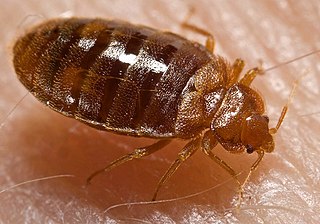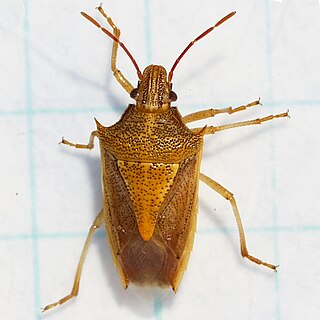
Hemiptera is an order of insects, commonly called true bugs, comprising over 80,000 species within groups such as the cicadas, aphids, planthoppers, leafhoppers, assassin bugs, bed bugs, and shield bugs. They range in size from 1 mm (0.04 in) to around 15 cm (6 in), and share a common arrangement of piercing-sucking mouthparts. The name "true bugs" is often limited to the suborder Heteroptera.

N,N-Diethyl-meta-toluamide, also called diethyltoluamide or DEET, is the oldest, most effective and most common active ingredient in commercial insect repellents. It is a slightly yellow oil intended to be applied to the skin or to clothing and provides protection against mosquitoes, flies, ticks, fleas, chiggers, leeches, and many other biting insects.

Horse-flies and deer flies are true flies in the family Tabanidae in the insect order Diptera. The adults are often large and agile in flight. Only female horseflies bite land vertebrates, including humans, to obtain blood. They prefer to fly in sunlight, avoiding dark and shady areas, and are inactive at night. They are found all over the world except for some islands and the polar regions. Both horse-flies and botflies (Oestridae) are sometimes referred to as gadflies.

Dermestidae are a family of Coleoptera that are commonly referred to as skin beetles. Other common names include larder beetle, hide or leather beetles, carpet beetles, and khapra beetles. There are over 1,800 species described.

The members of the Triatominae, a subfamily of the Reduviidae, are also known as conenose bugs, kissing bugs, or vampire bugs. Other local names for them used in the Americas include barbeiros, vinchucas, pitos, chipos and chinches. Most of the 130 or more species of this subfamily feed on vertebrate blood; a very small portion of species feed on invertebrates. They are mainly found and widespread in the Americas, with a few species present in Asia and Africa. These bugs usually share shelter with nesting vertebrates, from which they suck blood. In areas where Chagas disease occurs, all triatomine species are potential vectors of the Chagas disease parasite Trypanosoma cruzi, but only those species that are well adapted to living with humans are considered important vectors. Also, proteins released from their bites have been known to induce anaphylaxis in sensitive and sensitized individuals.

In science fiction and fantasy literatures, the term insectoid ("insect-like") denotes any fantastical fictional creature sharing physical or other traits with ordinary insects. Most frequently, insect-like or spider-like extraterrestrial life forms is meant; in such cases convergent evolution may presumably be responsible for the existence of such creatures. Occasionally, an earth-bound setting — such as in the film The Fly (1958), in which a scientist is accidentally transformed into a grotesque human–fly hybrid, or Kafka's famous novella The Metamorphosis (1915), which does not bother to explain how a man becomes an enormous insect — is the venue.

Reduvius personatus or the masked hunter is an insect belonging to the assassin bug (Reduviidae) family. The name is because its nymphs camouflage themselves with dust. The masked hunter is a predator of small arthropods, including woodlice, lacewings, earwigs, bed bugs and termites. Masked hunters do not feed on human blood, but can sting humans in self-defense when mishandled. The sting can be painful, but masked hunters do not carry Chagas disease unlike the kissing bug for which they are sometimes mistaken.

The Yellow admiral or Australian admiral is a butterfly native to Australia, New Zealand, Lord Howe Island, and Norfolk Islands. The Māori name is kahukōwhai, which means "yellow cloak". The yellow admiral is a member of the family Nymphalidae, the subfamily Nymphalinae as well as the tribe Nymphalini.

Traumatic insemination, also known as hypodermic insemination, is the mating practice in some species of invertebrates in which the male pierces the female's abdomen with his aedeagus and injects his sperm through the wound into her abdominal cavity (hemocoel). The sperm diffuses through the female's hemolymph, reaching the ovaries and resulting in fertilization.

The hawthorn shield bug is a common European shield bug. Its chief food is haws, the fruit of the hawthorn tree, but adults can overwinter on a diet of leaves, and individuals can be found on many potential food plants, including pedunculate oak, sessile oak and whitebeam. They may grow up to 17 mm (0.67 in) long, and are camouflaged in shades of green and brown. Like many so-called "stink bugs", they may release unpleasant odours when disturbed.

Cimex is a genus of insects in the family Cimicidae. Cimex species are ectoparasites that typically feed on the blood of birds and mammals. Two species, Cimex lectularius and Cimex hemipterus, are known as bed bugs and frequently feed on humans, although other species may parasitize humans opportunistically. Species that primarily parasitize bats are known as bat bugs.

Coccinellidae is a widespread family of small beetles. They are commonly known as ladybugs in North America and ladybirds in the United Kingdom; "lady" refers to mother Mary. Entomologists use the names ladybird beetles or lady beetles to avoid confusion with true bugs. The more than 6,000 described species have a global distribution and are found in a variety of habitats. They are oval beetles with a domed back and flat underside. Many of the species have conspicuous aposematic (warning) colours and patterns, such as red with black spots, that warn potential predators that they taste bad.

Eurydema oleracea is a species of shield bug in the family Pentatomidae and is commonly known as the rape bug, the crucifer shield bug, the cabbage bug or the brassica bug.

Niphograpta is a genus of moths of the family Crambidae. It contains only one species, the water hyacinth moth. It is native to the Amazon basin, but has been introduced in North America, Africa and Australia to control the spread of water hyacinth.

Insects are hexapod invertebrates of the class Insecta. They are the largest group within the arthropod phylum. Insects have a chitinous exoskeleton, a three-part body, three pairs of jointed legs, compound eyes, and a pair of antennae. Insects are the most diverse group of animals, with more than a million described species; they represent more than half of all animal species.

Stenotus binotatus is a species of plant bug, originally from Europe, but now also established across North America and New Zealand. It is 6–7 mm (0.24–0.28 in) long, yellowish, with darker markings on the pronotum and forewings. It feeds on various grasses, and can be a pest of crops such as wheat.

Trichopoda pennipes is a species of feather-legged fly in the dipteran family Tachinidae.

Oebalus pugnax, the rice stink bug, is a flying insect in the shield bug family Pentatomidae native to North America that has become a major agricultural pest in the Southern United States. It has been a known pest since at least the time of Johan Christian Fabricius, who described the species in 1775.
Larva is a South Korean 3D computer-animated television series made by TUBA Entertainment in Seoul, South Korea. Its two main characters are two larvae that never speak, although they do make expressive sounds. The cartoon exists in their small world where miniature adventures occur.

Rhabdomiris is a genus of true bugs belonging to the family Miridae.



















